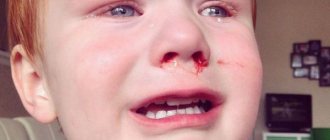Causes of birth trauma
Predisposing factors to clavicle fracture in newborns:
- discrepancy between the size of the fetus and the mother's pelvis, which is observed when a large child is born or a clinically narrow pelvis;
- incorrect position of the fetus - gluteal or leg, sometimes transverse;
- chronic intrauterine fetal hypoxia;
- premature birth;
- post-term pregnancy;
- rapid or prolonged labor.
But not in every one of these cases there is a turning point. Birth trauma can also be caused by the following factors:
- application of obstetric forceps;
- excessive protection of the perineum;
- stimulation of labor;
- use of Werbow's bandage or Kristeller's maneuver.
Most often, a fracture of the collarbone in a newborn occurs when an attempt is made to apply gentle traction by the head, or to extract the child by the chest at a time when the shoulders have not yet been born.
Clavicle injury occurs more often in children with a wide shoulder girdle and heavy weight. A large fetus can appear due to a hereditary predisposition in women with gestational diabetes mellitus.
The most common diagnosis is a fracture of the right clavicle. This is due to the peculiarities of the position of the fetus during childbirth - it takes the first position, in which the right shoulder is born first.
A rare cause of fracture is osteogenesis imperfecta. Pathology can lead to injuries to other parts of the body, for example, the risk of injury to the humerus increases, especially in children in the breech position. Osteogenesis imperfecta is a genetic abnormality, so throughout a child’s life, frequent bone fractures and spinal curvature are possible.
Typical symptoms of birth trauma
A collarbone injury is diagnosed immediately after childbirth, but sometimes the initial examination reveals nothing. According to some signs, it is determined over the next few hours or days:
- swelling and/or redness, hematoma in the clavicular area (we recommend reading: how is a hematoma on a child’s head that appears during childbirth treated?);
- pain when touching the injured area;
- decreased appetite, anxiety;
- limited limb mobility;
- crunching when moving the hand;
- uncharacteristic position of the shoulders relative to each other;
- arm hanging;
- incorrect head position.
A clavicle fracture in a newborn occurs due to immature muscles and joints
How does a clavicle fracture appear?
Symptoms of a fracture are most often noticeable immediately. In the first days, the movements of a baby's limbs are chaotic, they do not obey consciousness. Already in the first day it will be noticeable that the trajectory of one hand is different from the second, its swings are less active. It is urgent to show the child to the doctor if his arm does not move.
After a day, redness and swelling become noticeable at the site of injury, and a hematoma may appear. During swaddling, the baby screams loudly. A sharp cry appears when pressing on the collarbone, and at this time a crunch is felt under the fingers. Due to the unpleasant sensations, the newborn's sleep is disturbed and he has trouble latching on to the breast.
In children, the bone is covered with a layer of soft periosteum, so fractures occur in a “greenstick” fashion. This means that the inner part of the bone is destroyed, there is no trauma with displacement of fragments that are restrained by the intact periosteum.
Fracture of the collarbone in a child: causes
In most cases, the fracture occurs in the area of the diaphysis (the middle part of the long bone), since this place is the thinnest and most curved. The main factor in the injury is the impact of a fall on the hand or elbow. Damage occurs during active games and sports, especially often in children under 4 years of age, when they do not know how to fall correctly and have problems with coordination.
Cracks from a blow to the collarbone itself are a rare occurrence; injury is possible only in the event of an accident or a fall from a great height.
Often in children under 2 years of age, damage to the shoulder girdle occurs due to a new stage - independent walking. At older ages, riding a skateboard or bicycle is considered a risk of injury, falling from which often leads to fractures and dislocations.
By the age of 20, the collarbone becomes as strong as possible.
Types of clavicle fractures and features in children
Like all fractures, a clavicle injury can be:
- Open and closed.
- With and without offset.
- Complete and partial (called subperiosteal)
Open fractures with displacement occur when the skin is damaged by a fragment and are very rare. May occur in the event of a strong impact, an accident, or a fall from a height. Surgical treatment is mandatory.
Closed ones are not uncommon. Damage is classified depending on the direction of impact:
- oblique;
- transverse;
- screw;
- splintered.
The latter pose the greatest danger; bone fragments can damage arteries and nerve plexuses, leading to fracture complications.
Frequent children's fractures are subperiosteal, since a feature of the course of injury in children is the natural flexibility of bone tissue. Such fractures are also called “greenstick” or “willow twig” fractures - when the bone breaks under the periosteum (outer layer), keeping the more elastic tissue intact. In this case, the structure of the clavicle itself is not damaged, keeping the bone fragments together; in rare cases, only a slight displacement is possible.
Possible complications
To avoid complications, it is necessary to start treatment as early as possible. If the parents did not notice the injury in time and the child was not examined by a neonatologist, after a few days the bone will begin to heal on its own. In this case, callus formation occurs. The consequence of improper bone fusion is the formation of a false joint.
The fracture affects the child’s adaptation period. After childbirth, physiological weight loss occurs, but after an injury, children lose body weight more rapidly, so it is difficult for them to recover and begin to gain weight.
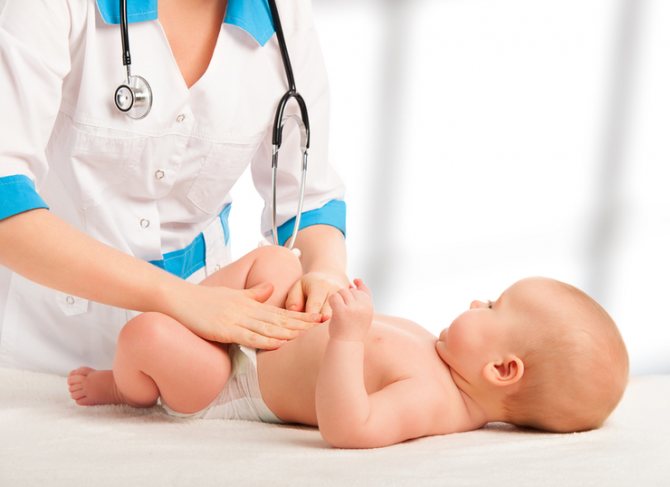
Treatment of birth trauma is comprehensive
The consequences may be associated with a more severe injury or a combination of several injuries. Damage to the brachial plexus is dangerous, which can occur during childbirth in the breech presentation if the fetus is removed by the pelvis. The pathology manifests itself in the form of swelling, hemorrhage and damage to the nerve roots in the brachial plexus. Neurological signs depend on the extent of damage and may include the following:
- Erb's palsy - occurs when the roots of the 5th and 6th spinal nerves leading to the arm are damaged;
- Klumpke's palsy - the lower part of the plexus is damaged;
- total paralysis of a limb - damage to the entire plexus, it is noticeable that the arm does not move after birth;
- phrenic nerve palsy – when the processes of the 3rd and 4th spinal nerves are involved in the pathological process.
If a newborn is diagnosed with birth plexitis or paralysis of the arms, this pathology is not associated with damage to the clavicle or brachial plexus. Spinal injuries lead to paralysis.
Diagnostic methods
The doctor may suspect a fracture already during the initial examination of the newborn in the delivery room. It takes into account how the birth took place. A thorough examination of the shoulder girdle is required in the following cases:
- rapid labor;
- application of obstetric forceps or other techniques;
- difficult birth of shoulders;
- heavy weight of the newborn.
During the examination, the doctor may detect crepitus in the collarbone area. Swelling and hematoma appear no earlier than the next day.
The Moro reflex helps check the combined movement of the limbs. This is spinal motor automatism, which is normally present in infants up to 4–5 months, and then begins to fade away. To check it, the child is placed on his back on a changing table. The doctor sharply hits the table surface with his palms 15 cm from the head. Another way to trigger the reflex is to raise your straightened legs and pelvis above the bed. Manifestations of automaticity go through 2 phases:
- the child moves his arms to the sides and unclenches his fists;
- after a few seconds the limbs return to their original position.
Treatment rules
For the success of treatment, it is important to start it as early as possible. In children, reparative processes proceed much faster than in adults. Therefore, after a fracture, a callus may already form on days 3–4, fixing the bone in the wrong position.
After confirming the diagnosis, the doctor places a special cushion in the armpit and fixes the arm in a special position. It is immobilized with a bandage, which is not recommended to be removed. If the child was able to remove the injured arm, it is necessary to consult a doctor again for proper fixation.
In order for the fracture to heal well, the following rules must be followed:
- do not place the child on the injured side;
- During feeding, the affected side should not press against the mother;
- do not remove the bandage for 10–14 days;
- monitor the condition of your fingers.
Blueness and swelling of the fingers in a newborn are associated with impaired blood flow due to compression of blood vessels by a too tight bandage or displacement of the cushion. When this symptom appears, it is necessary to immediately loosen the bandage. Possible consequences are limb ischemia and additional nerve damage.
The course of treatment includes vitamin K for children with extensive hematoma. After the bone heals, a period of rehabilitation is necessary. The child is prescribed massage, exercise therapy, magnetic therapy and electrophoresis. In order for a newborn to gain weight well, the mother’s nutrition must be complete, breastfeeding should be done on demand, but at least every 2 hours.
Damage to skeletal bones during childbirth is often associated with incorrect provision of benefits to children in the wrong position. To prevent these complications, the doctor may decide on the need for episiotomy or perineotomy. An incision in the perineum will cause additional problems for the mother, but will avoid serious injury to the child.
source
Clavicle fracture in newborns: what you need to know
A clavicle fracture in newborns during childbirth is a common injury in which the integrity of the clavicular bone is disrupted. According to the latest statistics, there are 11-12 cases per 1000 newborns. The fracture occurs during childbirth and does not depend on the course of pregnancy. It is important that the doctor makes a diagnosis in time and begins treatment to avoid consequences. Bone damage is diagnosed almost immediately after birth. Sometimes, due to the appearance of edema and hematoma, the diagnosis is made several days after birth. Rehabilitation measures play an important role in the restoration of the collarbone and joint.
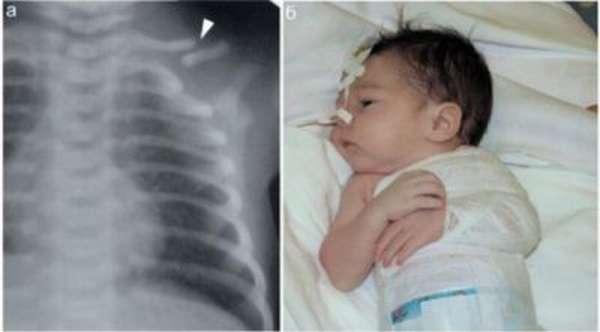
If the injury is diagnosed in time, there are usually no serious consequences at this age. But if the injury is serious and not detected in time, the baby’s immunity decreases, which creates a risk of developing infections. A promptly identified, properly treated fracture does not subsequently affect the musculoskeletal function of the joint. If it was treated incorrectly, the collarbone may not heal for a long time, and a false joint appears at the site of damage.
In rare cases, fragments of a broken collarbone provoke bleeding due to damage to the neurovascular bundle.
Clavicle fracture in children
A clavicle fracture in children is a fairly common injury. According to statistics, it ranks third in frequency after fractures of the shoulder and forearm.
Causes
In young children, subperiosteal fractures are most common; in school-age children, complete fractures of the clavicle are usually diagnosed.
The collarbone, as a result of indirect force, breaks at the border between the outer and middle parts of the bone. It is in this part that it is thinner, and its anatomical curvature is more pronounced. If there is a direct blow to the shoulder girdle, then the collarbone breaks in its outer part.
Features of clavicle damage in childhood
In newborns and young children, the collarbone breaks in a greenstick fashion. In this case, the bone itself is damaged, but the periosteum remains intact. She holds the sharp edges of her broken collarbone together. Most often, transverse fractures occur; in rare cases, oblique fractures occur.
In older children, the collarbone is thicker, with pronounced curves. The type of clavicle fracture they have is transverse, oblique or comminuted. The displacement of bone fragments relative to each other varies greatly. The weight of the upper limb and muscle tension cause one of the fragments (located closer to the sternum) to move up and back, while the other (peripheral) moves down and forward. In childhood, open fractures of the clavicle are extremely rare ; usually bone fragments themselves damage the skin and nearby tissues.
Symptoms
Subperiosteal fracture . With this type of clavicle injury, moderate swelling appears in the area of the bone injury, and the pain syndrome is mild. Sometimes there may be slight bruising in the area of injury. In this case, the child very rarely complains to the parent
Causes and factors causing clavicle fracture in newborns
The collarbone is a thin tubular bone that connects one end to the chest and the other to the shoulder blade. During childbirth, the right collarbone is more often broken, this is due to the physiological position of the fetus during childbirth. The causes of such injuries in newborns can be different. There are a number of main causes of clavicle fracture during childbirth.
Quick birth
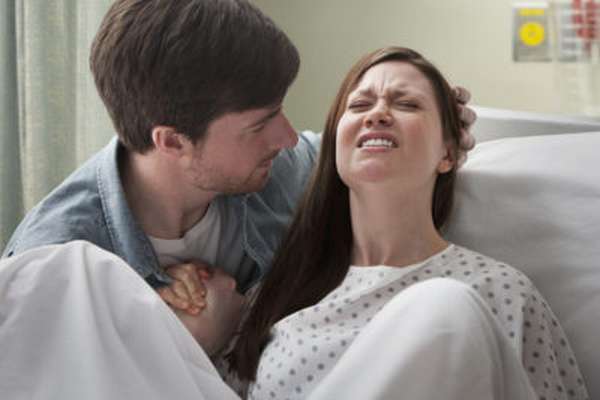
In some women, labor occurs so quickly that the fetus does not have time to take the correct position and is injured as it passes through the birth canal. This is one of the reasons why the clavicle bone breaks during childbirth in babies.
Unqualified medical assistance
If childbirth is difficult, the baby is stuck in the birth canal, doctors help the baby by turning him over. Through carelessness or lack of experience, in a hurry, the doctor touches the newborn’s body, breaking a collarbone or arm.
The size of the newborn is larger than the size of the birth canal
The baby inside the mother grows so big that, passing through the mother’s narrow birth canal, it causes harm to both itself and her. The doctor, having examined the baby during an ultrasound examination, is obliged to warn the mother about the large fetus and the consequences of its passage through the birth canal, and that there may be complications during natural childbirth. In this case, gynecologists suggest a caesarean section.
Clavicle fracture in a newborn. Birth injuries of newborns
Home and family Children Av. Daria Osipovskaya
Injuries during childbirth are quite common, no matter how hard doctors try to avoid them. Women do not always behave correctly during contractions, the fetus does not always behave as it is written in textbooks for obstetricians - there are many unpredictable moments. Therefore, injuries do occur; fortunately, they are generally not too serious and do not require long-term treatment and rehabilitation.
Childbirth from the fetal point of view
Many pregnant women are waiting, but at the same time they are afraid of the moment when they see their baby. This is not surprising, given how scary and painful childbirth is rumored to be. But some women completely forget that not only they, but also their children have to go through this difficult path, fraught with serious trials, when a lot depends on the actions of strangers - doctors.
Indeed, if you think about it, during childbirth, babies have to find themselves in a very traumatic situation. For almost 40 weeks, the child lived in a warm womb, heard the beating of his mother’s heart, ate, breathed and got rid of waste products through the umbilical cord - in a word, he was in very comfortable conditions. But now the old home is literally pushing him out, expelling him from itself. And in order to see the new world, he needs to go through a narrow passage. During this journey, the baby’s skull bones are displaced, and he also causes terrible inconvenience to his mother. In general, this path can hardly be called pleasant, although it was intended that way by nature itself. It is not surprising that it can be accompanied by various types of damage.
Birth injuries of newborns
Despite the naturalness of the process, quite often something does not go quite as it should. Fortunately, the development of medicine makes it possible to help women if there are any problems. But also too
Source
Main symptoms
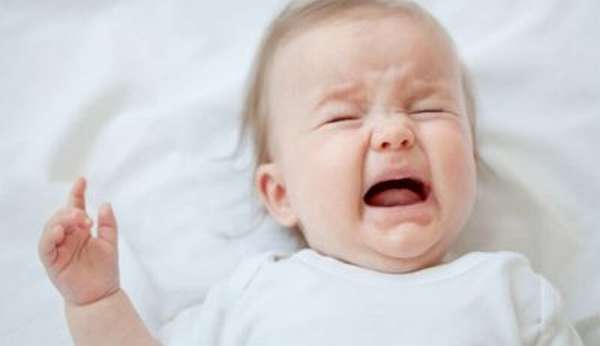
It is not difficult for an experienced doctor to understand that a fracture of the collarbone of a newborn occurred during childbirth - the injury has pronounced signs of fractures:
- hematoma in the affected area, swelling,
- When swaddling the baby cries all the time,
- when palpating the affected area, a specific crunching sound is heard,
- the baby does not move his arms in the same way,
- in especially severe cases, when fragments are displaced, the handles are limited in movement.
If the doctor did not diagnose the injury in time, a clearly defined bone callus can be felt at the fracture site after a week. Having noticed a callus, parents should, after discharge from the hospital, make an appointment with a pediatric surgeon. To make an accurate diagnosis, the baby is prescribed x-ray diagnostics.
What is a clavicle fracture?
A clavicle fracture is a pathological condition that develops as a result of mechanical impact on the integrity of the bones (clavicle). According to statistics, clavicle fracture occurs in 4% of newborns. Violation of the integrity of the bone can occur at the thoracic or acromial end, and such injuries are also divided into comminuted, multi-comminuted, or those that have oblique or perpendicular lines. Fractures with bone displacement are considered the most dangerous, since they can damage nerve endings, blood vessels, and the pleura of the lungs, which can cause significant harm to the baby. Normally, the clavicle is a paired tubular bone that is part of the shoulder girdle. This bone is quite fragile and can crack or break even with slight pressure. It is not at all difficult to recognize a fracture of the collarbone in a newborn child, since the baby cries a lot after birth, and in the area of the damage there will be swelling or edema, which immediately catches the eye. In newborn babies, a clavicle fracture is often called a "green stick" fracture, meaning that the bone is broken but the periosteum remains intact. This condition is the most common, responds well to treatment and does not harm the baby in the future. In children, a complete bone fracture almost never occurs, just as open fractures of the clavicle do not occur.
First aid for newborns with a broken collarbone
A damaged collarbone in a newborn must be immobilized during childbirth. This is done using a Deso bandage. The arm in a half-bent position is bandaged to the baby’s body. If swelling or hematoma is found at the fracture site, the doctor prescribes vitamin K injections, which are administered intravenously. Traumeel S with an analgesic, anti-inflammatory and regenerative effect or another ointment as prescribed by a doctor is applied to the fracture site. The gel is rubbed all over the handle to obtain a rapid therapeutic effect.
During the entire time that the baby’s arm is in a bandage, it is recommended to place it only on the healthy side. In an infant, the clavicle fracture heals completely after three weeks. And if everything is done correctly, no complications, as a rule, are observed.
Fracture of the collarbone in a newborn during childbirth - consequences - OrthoDoc
Without exception, all expectant mothers look forward to the day when their baby is born. Each woman's idea of childbirth can vary dramatically.
Some are counting the minutes until the process begins, while others are worried about possible painful sensations.
As you know, babies are not always born easily, so you need to be mentally prepared for the fact that various kinds of complications may arise.
But they should not be attributed to the negligence of the staff, since some of the doctor’s actions are forced and are performed for the benefit of the woman herself and her baby. A common problem that occurs when a baby is born is a fracture of the collarbone. What to expect in such a situation, and is it dangerous for the little man?
Fracture of the collarbone during childbirth in a newborn: symptoms, treatment and rehabilitation
According to statistics, a clavicle fracture in newborns during childbirth is a fairly common injury.
Usually, an obstetrician-gynecologist makes a diagnosis immediately after birth during an examination of the baby. But in some cases, the injury is noticed after 2-3 days, when hematoma and swelling appear.
Treatment of a fracture or dislocation of the collarbone in a newborn child during childbirth and possible consequences
Injuries during childbirth happen quite often, no matter how hard experts try to avoid them. It is impossible to predict the circumstances and their course, even if the pregnancy was without complications. Many problems and risks can be avoided if a woman learns in time how to behave during labor, undergoes all the necessary examinations and prepares herself mentally.
Fracture and dislocation of the collarbone in a baby are common birth injuries
Effective treatments
In newborns, the rate of bone tissue recovery is amazing. This feature protects young children from the consequences of fractures at birth. If the collarbone is broken by an adult, the formation of a callus occurs within two to three weeks; a clavicle fracture in newborns begins to heal within a week, and is restored after 20 days.
For newborns with a clavicle fracture, plaster is not applied to the fracture; a Deso bandage is used when the injured limb is tightly bandaged to the body in a bent state. A soft cushion made of cotton wool and bandage is placed under the baby’s armpit. Parents should ensure that the baby lies on his healthy side at all times until recovery.
If the fingers on a bandaged hand turn blue, this indicates poor circulation. In this case, it is necessary to loosen the bandage.
Treatment tactics
Do not self-medicate under any circumstances. Despite the fact that fractures in newborns heal more easily and quickly than in adults, treatment should only be carried out by a doctor.

First of all, the child’s hand needs to be immobilized with a bandage. To do this, it is tightly fixed to the body. Plaster is not applied for a clavicle fracture.
Make sure that the bandage is not too tight and does not interfere with the baby’s blood circulation. If your fingers begin to turn blue, you should ask your doctor to loosen the bandage.
Even though the bone will heal within a week, it is necessary to continue to immobilize the damaged limb for 14-30 days so that its functionality is fully restored and the bone is not damaged again.
If a child has a displaced fracture or a broken bone has been displaced during dressings or due to the child's movements, under no circumstances should you try to set it yourself. This can damage your baby's muscles, nerves or blood vessels, which in turn can lead to bleeding or paralysis. If the displacement is slight, the doctor will apply a Dezo bandage or Deba rings (a special shoulder fixator). If the bone is severely displaced, a double Cramer splint can be applied.
A comminuted fracture takes the longest to heal. In this case, surgical intervention is required, during which parts of the clavicular bone are fixed with a special splint or plate. Such a fracture takes about a month to heal, but it occurs extremely rarely in newborns due to the fact that the bones of infants are flexible.
For extensive hematoma, vitamin K injections are prescribed intramuscularly for three days. Traumeel-S ointment is also prescribed, which quickly relieves pain and swelling, has an anti-inflammatory effect and accelerates tissue regeneration.
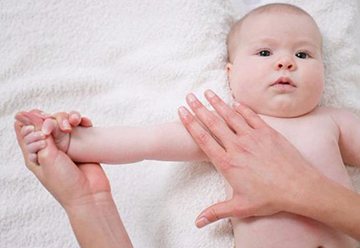
A child can sleep only on his back or healthy side.
During feeding, only the healthy side is applied to the breast.
For a speedy recovery of the baby, the mother must adhere to a well-balanced diet.
Breastfeeding women simply need to enrich their diet with calcium, phosphorus, silicon and magnesium. All these microelements influence the formation and restoration of bone tissue.
But it is important to understand that an excess of elements or consumption of certain foods can cause an allergic reaction or even poisoning in a child. Therefore, the diet must be agreed upon with the pediatrician. Children on artificial nutrition should also only be prescribed additional microelements by a doctor.
After a fracture, the baby will undergo a rehabilitation period necessary for a speedy recovery, which includes the following physical procedures:
- Electrophoresis. Helps medications penetrate through the skin directly to the site of a bone fracture.
- Physiotherapy. The mother should perform gentle abducting and adducting movements with the baby’s hand every day.
- Massage. Should only be carried out by a specialist.
Rehabilitation period
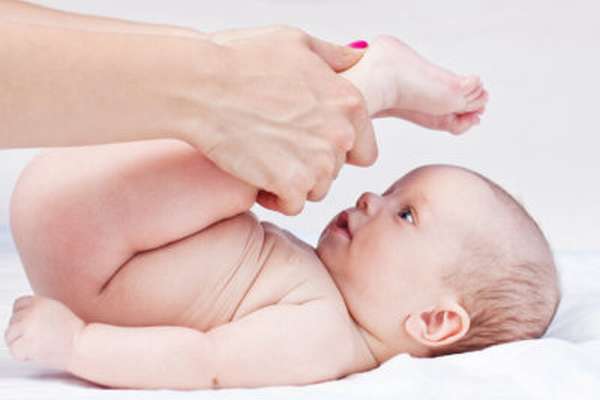
Rehabilitation includes a range of physiotherapeutic procedures:
- massage of the limb and joint, which should be carried out by a specialist,
- therapeutic and recreational exercises under the guidance of an experienced rehabilitation therapist,
- magnetic therapy sessions,
- electrophoresis sessions (promote better penetration of medications through the skin to the broken bone).
The rapid recovery of the baby is facilitated by the intake of vitamins and nutrients into the body through mother's milk. During this period, a woman needs to fill her diet with foods containing calcium, phosphorus, silicon and magnesium - microelements that promote bone tissue restoration.
source
Causes of clavicle fracture
The clavicle is a paired tubular bone, which is attached to the chest on one side and to the scapula on the other. A fracture of the right clavicle bone is more often diagnosed, this is due to the physiological position of the child during childbirth.
The main causes of clavicle injury:
- Breech presentation of the fetus. If the position is incorrect, then his clavicle and other bones are severely compressed. The risk of injury increases, especially with rapid labor;
- Narrow birth canal. Discrepancy between the width of the birth canal and the size of the fetus;
- Trauma due to manual or instrumental delivery;
- Imperfect bone formation is a hereditary pathology that increases bone fragility.
Causes of fracture
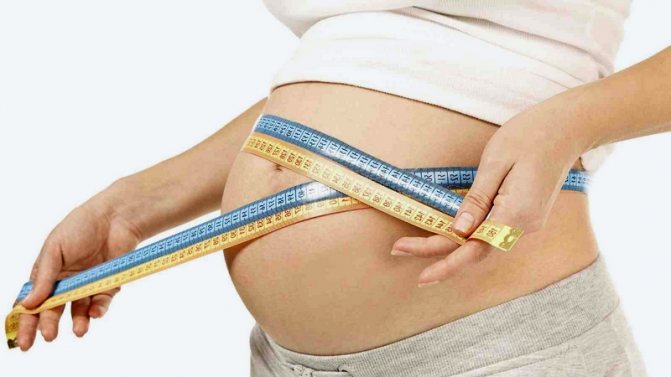
Too narrow pelvis + large fetus = direct indication for caesarean section
| Causes of birth injury: clavicle fracture | |
| Spontaneous | Obstetrics |
| Large fruit mass | Intentional incision of the collarbone during childbirth |
| Narrow pelvis in a woman in labor | Obstetric turn |
| Rapid labor | Drug acceleration of labor |
| Improper placement of the fetus | Injury from an auxiliary tool |
| Abnormal insertion of the fetal head | Vacuum extraction of the fruit |
On a note. In almost half of the children who received such an injury, the mother’s pelvis was of average size, which did not pose a problem for labor. The reason was excess weight of the fetus. That is why the doctor leading the pregnancy recommends following a vegetable diet for those pregnant women whose fetus is gaining “excess weight.”
A clavicle fracture in an infant is a rare occurrence. A baby who has not yet begun to walk can receive such an injury as a result of an accident or due to the careless behavior of relatives or medical staff.
Symptoms of injury
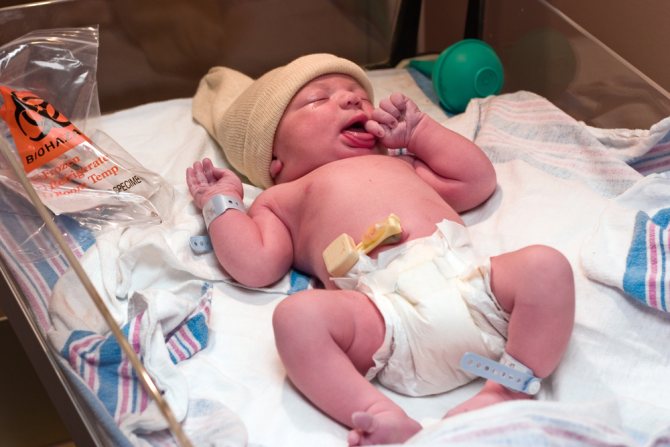
A greenstick fissure or fracture of the clavicula may have no obvious symptoms.
Sometimes the fracture goes unnoticed. If any signs are detected, parents should point them out to the neonatologist?
Signs of a clavicula fracture in a newborn:
- touching the collarbone and shoulder, squeezing them when swaddling, as well as movements in the shoulder joint while putting on things are painful and causes crying;
- visually, the protruding roundness of one collarbone is different from the other;
- the skin over the broken collar bone swells slightly and turns a little red;
- During palpation, the doctor will hear a characteristic crunching sound - bone crepitus.
If a fracture in infants and older children is “missed,” then a tubercle will be clearly palpable at the fracture site - a callus that forms at this age by 6-7 days after the injury.
Symptoms of a clavicle fracture in a newborn
The newborn is examined by a neonatologist who diagnoses the injury based on the following signs:
- Painful reaction to palpation of the collarbone;
- The supraclavicular region is smoothed;
- After some time, the soft tissues in the collarbone area turn red and swell;
- During palpation, bone fragments rub against each other and crunch;
- With a displaced fracture, the limb moves with difficulty.
The child’s appetite also decreases and he skips feedings. As a result, weight gain is difficult. The immune system is weakened, and there is a risk of infection entering the fracture site.
To confirm the injury, an x-ray examination must be performed.
Fracture of the collarbone in a newborn during childbirth - consequences
A clavicle fracture in a newborn during childbirth is a common injury that occurs due to physiological factors or errors by medical personnel. The baby's bones are still fragile and thin. In many ways, this helps during childbirth, when the baby moves through the birth canal, but the likelihood of a fracture always remains.
About childbirth and fracture
Often such damage occurs during rapid childbirth, when neither the female nor the child’s body has time to prepare for the process. Many expectant mothers dream of giving birth quickly, rather than suffering for days, but you should know that this can lead to additional complications.
In 90% of cases, a clavicle fracture is a consequence of inept actions of a gynecologist or obstetrician. When the baby's head has already come out, they begin to pull him by the shoulders, helping him to be born faster. Because of this additional physical impact, fractures occur.
Few people know that you can get such an injury during a caesarean section. If the doctor does not grasp the baby correctly when removing him from the uterine cavity, there is a possibility of breaking the integrity of the bone. Another common injury is a dislocated collarbone in an infant.
Regardless of the diagnosis, urgent treatment is required to avoid negative consequences during growing up.
What is the clavicle
To understand why a clavicle fracture occurs in newborns, you must first become familiar with the structure of the children's skeleton. The collarbone is an important component of it. This S-shaped bone connects the sternum to the shoulder blades. This organ is a pair; each person has a right and a left collarbone.
Dice Features:
- Miniature sizes;
- When raising the shoulder girdle, the movement of the bone resembles turning a key in a keyhole, which is how it got its name;
- The fragility of the bone is compensated by its location, the likelihood of injury in adulthood is minimal.
According to the classification, the clavicle belongs to the long bones of the skeleton, but it is not hollow, but spongy, like short bones. This is another of its features. If the integrity of the clavicle is violated, there is a high probability of destructive changes in the structure of the upper limbs. For this reason, the fact that a newborn has a fracture cannot be ignored.
In children, bones knit together at record speed. This is both an advantage and a noticeable disadvantage in the process of treating birth injuries. If a violation of the integrity of the clavicle is not detected in a timely manner, there is a possibility that it has already fused incorrectly. Then the child will have to have a serious operation.
Why does a clavicle fracture occur during childbirth?
There are two main causes of a clavicle fracture during childbirth in a baby. The first prerequisite is insufficient preparation of the birth canal. If the pelvic bones of a woman in labor are not sufficiently diverged, it is difficult for the baby to come out. The result is a long, painful labor, injuries to the baby, and significant tears in the mother’s perineum.
The second reason is the incorrect actions of medical personnel during childbirth. If natural childbirth with minimal external influence on the process is now becoming increasingly popular, previously maternity hospitals actively tried to speed up the birth of a child. They simply pulled him out as soon as he appeared in the birth canal.
Due to the strong physical impact, such injuries occurred. Now there are much fewer of them, but they are still diagnosed, especially in provincial maternity hospitals, where outdated delivery protocols are still used.
With a breech baby, there is also a high probability of receiving a birth injury, so more and more obstetricians and gynecologists agree that this is a direct indication for a cesarean section. The likelihood of a clavicle fracture in this case is reduced, but does not disappear completely.
Signs of a clavicle fracture in a newborn
A fracture of the collarbone during childbirth in a child is diagnosed in the maternity hospital. Often such injuries are noticed by neonatologists in the delivery room during the first examination of the baby. Sometimes bone integrity problems appear the next day.
Young mothers should know the symptoms and manifestations of fractures in order to promptly contact doctors for help:
- The baby's tearfulness, his poor health;
- Disturbances in sleep, diet, complete refusal of breastfeeding;
- Limited hand mobility;
- Swelling and hematoma in the collarbone area;
- Crying when pressing on this area due to severe pain.
If any of the above symptoms appear, you should immediately let your doctor know about them. In some maternity hospitals, unscrupulous doctors are silent about the presence of injury, although they themselves immediately notice it. Their motivation is simple - if a fracture is detected at home, then it is problematic to prove that it was caused during childbirth due to the incompetence of the doctor.
If you see that something is wrong with the child, he is acting restless, does not sleep, does not eat, and constantly cries, raise the alarm. Don’t leave a choice to the medical staff; insist on an examination.
Diagnosis of a fracture
X-rays are not recommended for newborns, but they are necessary in case of a fracture. Don't worry too much about this. Radiation doses are selected very carefully to minimize potential harm. If you treat a baby without such an examination, the likelihood of improper bone fusion increases.
Source: https://Sustavi.guru/perelom-klyuchitsy-u-novorozhdennogo-pri-rodah.html
Treatment methods
Fractures in infants heal much faster than in adults; a cast and surgery are only necessary in rare cases. First of all, when a newborn has a fractured collarbone, it is necessary to immobilize the damaged limb.
To limit movements, an elastic and soft Deso bandage is used.
A cotton roll is inserted into the axillary area, the limb is bandaged to the body, but the bandage should not be tight: this can interfere with blood circulation and the child’s fingers will turn blue.
The duration of fracture healing is 7 days. The damaged limb must be fixed for another 30 days in order for its functionality to be fully restored.
If a baby develops a cephalohematoma (extensive hemorrhage with a bulge) in the area of the fracture, then additional treatment is necessary. For this purpose, a solution for injection, Kanavit (vitamin K), is prescribed, which is administered intravenously. The course of treatment is 3 days.
Also, for a hematoma, the doctor may prescribe Traumeel S ointment based on herbal and mineral components. The drug relieves pain, stops bleeding, relieves swelling, and eliminates the inflammatory process. The drug is safe for infants; not only the broken clavicle bone, but also the trapezius muscle can be treated.
For 14 days, the little patient should sleep only on his healthy side or back; during feeding, also turn him over to his healthy side. This is a treatment option for a common fracture or crack in the collarbone.
If the broken clavicle bone has moved, then under no circumstances try to put it back in place yourself . This can damage muscles, important nerves or blood vessels, causing bleeding or muscle paralysis. Go to the hospital where a pediatric traumatologist will provide treatment.
If the displacement is slight, a Deso bandage or Delba rings are applied. And in case of severe displacement, a double Kramer splint is applied. In particularly severe cases, surgery will be required.
In case of a comminuted fracture, parts of the clavicle are fixed with a special splint or plate. Such a fracture heals in 30 days or more.
It is necessary to visit a doctor for an examination, diagnosis and proper treatment. In most cases, treatment has a favorable outcome, as the bones in infants heal quickly.
Fracture of the collarbone during childbirth in a newborn: symptoms, treatment and rehabilitation
According to statistics, a clavicle fracture in newborns during childbirth is a fairly common injury.
Usually, an obstetrician-gynecologist makes a diagnosis immediately after birth during an examination of the baby. But in some cases, the injury is noticed after 2-3 days, when hematoma and swelling appear.
Causes of clavicle fracture
The clavicle is a paired tubular bone, which is attached to the chest on one side and to the scapula on the other. A fracture of the right clavicle bone is more often diagnosed, this is due to the physiological position of the child during childbirth.
The main causes of clavicle injury:
- Breech presentation of the fetus. If the position is incorrect, then his clavicle and other bones are severely compressed. The risk of injury increases, especially with rapid labor;
- Narrow birth canal. Discrepancy between the width of the birth canal and the size of the fetus;
- Trauma due to manual or instrumental delivery;
- Imperfect bone formation is a hereditary pathology that increases bone fragility.
Symptoms of a clavicle fracture in a newborn
The newborn is examined by a neonatologist who diagnoses the injury based on the following signs:
- Painful reaction to palpation of the collarbone;
- The supraclavicular region is smoothed;
- After some time, the soft tissues in the collarbone area turn red and swell;
- During palpation, bone fragments rub against each other and crunch;
- With a displaced fracture, the limb moves with difficulty.
The child’s appetite also decreases and he skips feedings. As a result, weight gain is difficult. The immune system is weakened, and there is a risk of infection entering the fracture site.
To confirm the injury, an x-ray examination must be performed.
If the collarbone is broken, but the doctor did not detect the injury after childbirth, then after 7 days a bone callus may appear. Parents should immediately consult a doctor; the pediatric surgeon will order an x-ray to check the correctness of the fusion.
Treatment methods
Fractures in infants heal much faster than in adults; a cast and surgery are only necessary in rare cases. First of all, when a newborn has a fractured collarbone, it is necessary to immobilize the damaged limb.
To limit movements, an elastic and soft Deso bandage is used.
A cotton roll is inserted into the axillary area, the limb is bandaged to the body, but the bandage should not be tight: this can interfere with blood circulation and the child’s fingers will turn blue.
The duration of fracture healing is 7 days. The damaged limb must be fixed for another 30 days in order for its functionality to be fully restored.
If a baby develops a cephalohematoma (extensive hemorrhage with a bulge) in the area of the fracture, then additional treatment is necessary. For this purpose, a solution for injection, Kanavit (vitamin K), is prescribed, which is administered intravenously. The course of treatment is 3 days.
Also, for a hematoma, the doctor may prescribe Traumeel S ointment based on herbal and mineral components. The drug relieves pain, stops bleeding, relieves swelling, and eliminates the inflammatory process. The drug is safe for infants; not only the broken clavicle bone, but also the trapezius muscle can be treated.
For 14 days, the little patient should sleep only on his healthy side or back; during feeding, also turn him over to his healthy side. This is a treatment option for a common fracture or crack in the collarbone.
If the broken clavicle bone has moved, then under no circumstances try to put it back in place yourself . This can damage muscles, important nerves or blood vessels, causing bleeding or muscle paralysis. Go to the hospital where a pediatric traumatologist will provide treatment.
If the displacement is slight, a Deso bandage or Delba rings are applied. And in case of severe displacement, a double Kramer splint is applied. In particularly severe cases, surgery will be required.
In case of a comminuted fracture, parts of the clavicle are fixed with a special splint or plate. Such a fracture heals in 30 days or more.
It is strictly forbidden to self-medicate; if you find that your newborn has a broken collarbone, consult a doctor!
It is necessary to visit a doctor for an examination, diagnosis and proper treatment. In most cases, treatment has a favorable outcome, as the bones in infants heal quickly.
Rehabilitation period
In order for the child to recover faster, it is necessary to restore nutrition to the damaged area and strengthen the clavicle bone.
Post-traumatic rehabilitation includes the following procedures:
- Magnetotherapy – the effect of a multi-frequency magnetic field on the damaged area;
- Physical therapy also promotes recovery. The mother performs simple exercises: it is necessary to move the damaged limb away from the body, and then return it to its place;
- Massage promotes rapid healing, but should only be performed by a specialist. After the bone has fused, the mother can massage the shoulder on her own, this improves blood circulation;
- Electrophoresis is a physiotherapeutic method in which current and a special drug are applied to the body in order to restore it after injury;
- Proper nutrition is the key to a quick recovery. The best option for a baby is mother's milk, otherwise you need to eat foods that contain a lot of calcium, phosphorus, magnesium and silicon.
Consequences and complications
Competent and timely therapy guarantees rapid bone healing. In some cases, when the newborn's immune system is weakened, an infection can spread to the fracture site. A false joint may also form if the bone was not properly fixed or the fracture was severely displaced.
For severe pain, the doctor prescribes analgesic drugs that are administered intravenously, but this is only possible in inpatient treatment conditions.
Pain syndrome occurs if the brachial plexus or neurovascular bundle is damaged . But such complications arise in isolated cases.
Thus, a clavicle fracture is a common birth injury that does not pose any particular danger. An experienced doctor will identify the disease immediately after birth and prescribe proper treatment. Do not self-medicate, monitor the child’s condition and, if in doubt, go to the hospital.
Victor Systemov – expert of the 1Travmpunkt website
Source: https://1travmpunkt.com/perelom/raznie/klyuchicy-u-novorozhdennogo.html
Rehabilitation period
In order for the child to recover faster, it is necessary to restore nutrition to the damaged area and strengthen the clavicle bone.
Post-traumatic rehabilitation includes the following procedures:
- Magnetotherapy – the effect of a multi-frequency magnetic field on the damaged area;
- Physical therapy also promotes recovery. The mother performs simple exercises: it is necessary to move the damaged limb away from the body, and then return it to its place;
- Massage promotes rapid healing, but should only be performed by a specialist. After the bone has fused, the mother can massage the shoulder on her own, this improves blood circulation;
- Electrophoresis is a physiotherapeutic method in which current and a special drug are applied to the body in order to restore it after injury;
- Proper nutrition is the key to a quick recovery. The best option for a baby is mother's milk, otherwise you need to eat foods that contain a lot of calcium, phosphorus, magnesium and silicon.



